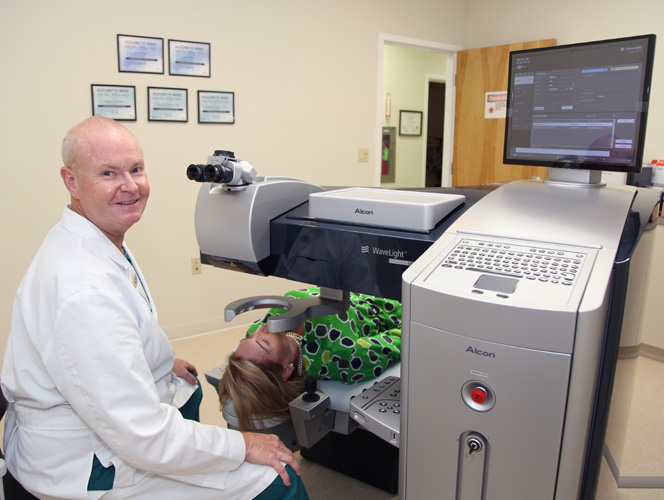
Dr. David O’Brien at New Vision Eye Center has some good news for the estimated 716,000 Americans who will have LASIK or laser-assisted in-situ keratomileusis eye surgery this year. Especially those who live in or near Vero Beach.
That good news comes, in part, from the “Wavelight EX500 Excimer Laser System” and the “Vario Topolyzer” that New Vision has just installed.
With the new technology, O’Brien says New Vision is “nearing the pinnacle of accuracy” in LASIK surgery.
LASIK is the most performed laser eye surgery in the world.
It is used to treat myopia (nearsightedness), hyperopia (farsightedness) and various astigmatisms which are, collectively, types of refractive errors in which the eye does not focus light evenly on the retina which results in distorted or blurred vision at any distance.
Other symptoms of astigmatisms can include eyestrain, headaches and trouble driving at night.
So, how does LASIK treat these problems? According to the Mayo Clinic, “during LASIK eye surgery, the surgeon creates a flap in the cornea, the transparent, dome-shaped surface of the eye, that accounts for a large part of the eye’s bending or refracting power. Then the surgeon uses a laser to reshape the cornea, which corrects the refraction problems in the eye.”
Easy, right?
No. It’s not. It requires incredible precision. The average cornea is only about 540 to 560 micrometers thick. That’s roughly half a millimeter or 0.02 of an inch. Re-sculpting such a delicate piece of material to improve vision is a demanding task.
According to the Cornea Research Foundation of America, the cornea is the clear, tissue-thin covering on the front of the eye. It acts much like the crystal on a watch – only much, much thinner – and serves as a protective window that allows light to enter the eye and come to focus on the retina.
As thin as it is, the cornea is, in fact, a multilayer layer structure, with three main components – the “epithelium,” which acts as a barrier to protect the cornea from dust, debris and bacteria; the “stroma,” which gives the cornea its strength and dome-like shape; and finally, the “endothelium,” which is one single layer of cells that provides the appropriate balance of fluid in the cornea, keeping it thin and crystal clear.
Precisely dealing with those three layers, according to O’Brien, is where New Vision’s latest laser system shines.
“The 500Hz laser ablates [or] vaporizes corneal tissue much more rapidly than the prior iterations,” O’Brien explains, “which shortens treatment time significantly, increasing patient comfort and decreasing anxiety over ‘fixation’ or staying still.
“The accuracy is further improved by the ability to track the eye for ‘cyclotorsion’ or rotation,” a feature not available in earlier LASIK systems.
“This,” O’Brien continues, “dramatically improves the ability to treat astigmatism, which is completely dependent on accuracy of ablation on the proper axis.”
He also points to the ‘Vario Topolyzer,’ a part of this new system that is used “to measure the eye surface and refraction prior to actual laser treatment and automatically send measurement data to the laser to calculate the treatment profile to optimize the tissue removal for precision accuracy to the micron.”
Then O’Brien makes the bold claim about nearing the pinnacle of accuracy.
“This technology – the combination of the Vario Topolyzer with the Wavelight EX500 Excimer Laser – is a significant advance in the capture of pre-operative measurements required to provide precision data to the laser computer which then calculates the optimal, individualized ablation pattern to be applied to the cornea for unprecedented outcomes of visual accuracy.”
While O’Brien, before the arrival of this new equipment, had a highly enviable one-half-of-one-percent re-treatment rate for these procedures, the national average is nearer to 10 percent.
O’Brien expects the new laser system will greatly “improve accuracy, particularly for astigmatic treatment,” across the country for those who adopt it, though he does say there’s more than just a new laser system involved in the effort to continue to lower re-treatment rates nationwide.
“The goal,” he concludes, “is zero percent re-treatment,” but he adds that “individual wound-healing is what may limit achievement of that goal.”
Is LASIK eye surgery something that could help you? You won’t really know until you go meet with a highly trained laser eye surgeon like O’Brien.
Dr. David O’Brien is with New Vision Eye Center at 1055 37th Place in Vero Beach. The phone number is 772-257-8700.



